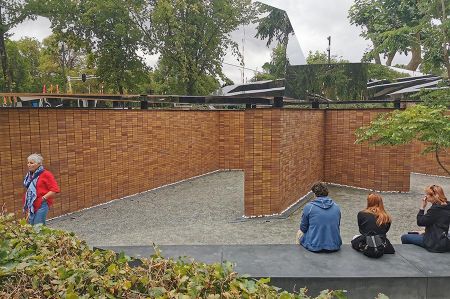“National Holocaust” name monument in Amsterdam
- Written by Portal Editor
Because of its canals and locks, Amsterdam has not only been known as a place of hydraulic engineering culture for centuries, but thanks to its very liberal politics and the accumulation of great art and artists, it is also a tourist destination, at least as well known for Anne Frank's diary, which has been read millions of times.
One more reason to also look at Amsterdam's engagement with the Holocaust.
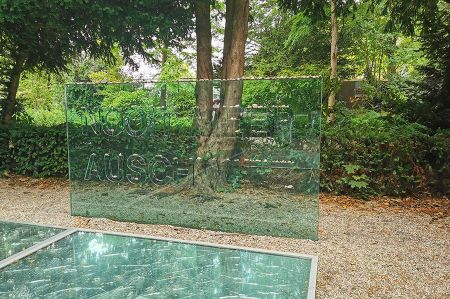 Every tourist who knows about Anne Frank's events will probably want to visit her place of residence, or rather her hiding place, in Amsterdam. Please register there in advance, as there is a huge rush. We gave up on it at the time of our planned visit. But there are very interesting alternatives if you want to deal with the subject of the Holocaust.
Every tourist who knows about Anne Frank's events will probably want to visit her place of residence, or rather her hiding place, in Amsterdam. Please register there in advance, as there is a huge rush. We gave up on it at the time of our planned visit. But there are very interesting alternatives if you want to deal with the subject of the Holocaust.
Holocaust Name Monument Amsterdam: One stone for each victim
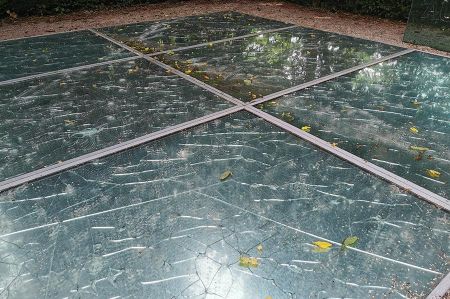 The National Holocaust Name Monument in Amsterdam is the national Holocaust memorial of the Netherlands, which is also dedicated to the Porajmos (genocide of the Sinti and Roma). It commemorates the approximately 102,000 Jewish victims from the Netherlands who were arrested, deported and mostly murdered in the Auschwitz and Sobibor extermination camps by the Nazi regime during the German occupation of the country (1940–1945), as well as the 220 victims from this population the Roma and Sinti.
The National Holocaust Name Monument in Amsterdam is the national Holocaust memorial of the Netherlands, which is also dedicated to the Porajmos (genocide of the Sinti and Roma). It commemorates the approximately 102,000 Jewish victims from the Netherlands who were arrested, deported and mostly murdered in the Auschwitz and Sobibor extermination camps by the Nazi regime during the German occupation of the country (1940–1945), as well as the 220 victims from this population the Roma and Sinti.
The monument is located in the Weesperstraat in Amsterdam-Centrum - near the former Jewish quarter - and was presented to the public on September 19, 2021 by King Willem-Alexander and Jacques Grishaver, chairman of the Netherlands Auschwitz Comité.
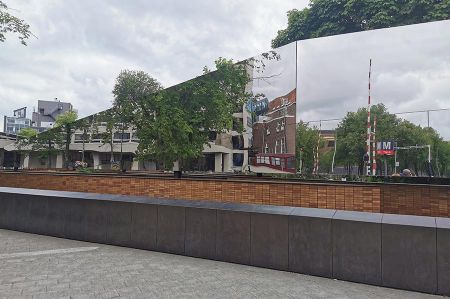 The monument consists of brick walls that, when viewed from above, can be read in the form of four Hebrew letters לזכר. Considered accordingly, they mean “In memory”. Each brick has a victim's name, date of birth and age at the time of the murder written on it. Visitors can walk around the four letters, the walls forming a labyrinth of passages. From above, the walls are closed off by a steel edge in which trees and clouds as well as the walls below are reflected. Almost 80 percent of the families listed by name were completely wiped out by the Nazi regime during the Shoah. “This monument gives the victims their name back 76 years after the end of the war and proves that they lived,” said Jacques Grishaver.
The monument consists of brick walls that, when viewed from above, can be read in the form of four Hebrew letters לזכר. Considered accordingly, they mean “In memory”. Each brick has a victim's name, date of birth and age at the time of the murder written on it. Visitors can walk around the four letters, the walls forming a labyrinth of passages. From above, the walls are closed off by a steel edge in which trees and clouds as well as the walls below are reflected. Almost 80 percent of the families listed by name were completely wiped out by the Nazi regime during the Shoah. “This monument gives the victims their name back 76 years after the end of the war and proves that they lived,” said Jacques Grishaver.
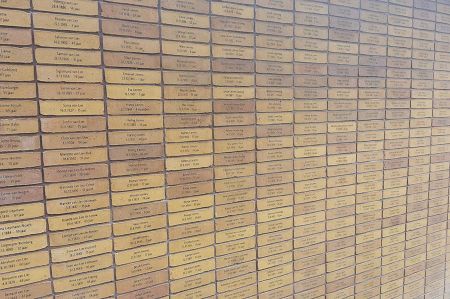 The memorial is one of a number of Holocaust memorials that attempt in different ways to record the names of the victims, most notably the Hall of Names at Yad Vashem, the Mémorial de la Shoah in Paris and the Jewish Museum of Thessaloniki, where on stone the names of the victims of the Shoah in Thessaloniki are engraved. The Name Walls memorial is under construction in Vienna, where the names of more than 64,000 murdered Jews in Austria are mentioned.
The memorial is one of a number of Holocaust memorials that attempt in different ways to record the names of the victims, most notably the Hall of Names at Yad Vashem, the Mémorial de la Shoah in Paris and the Jewish Museum of Thessaloniki, where on stone the names of the victims of the Shoah in Thessaloniki are engraved. The Name Walls memorial is under construction in Vienna, where the names of more than 64,000 murdered Jews in Austria are mentioned.
History of its creation
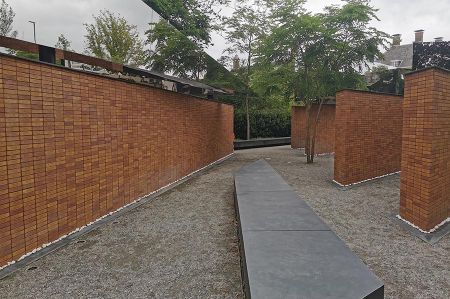 The initiative for the memorial came from the Dutch Auschwitz Committee, headed by Jacques Grishaver. It took 76 years since the fall of the Nazi regime until the monument could be completed and handed over to the public after years of legal disputes. Residents had tried to prevent the construction of the monument in court, among other things because it was too large and would encourage an influx of visitors. At the end of 2019, the objections were rejected in the final instance. The monument was financed primarily through donations. Numerous localities covered the costs of affixing the names of their slain Jewish citizens. It was designed by the Polish-American architect Daniel Libeskind. The local construction management was carried out by the Amsterdam architectural firm Rijnboutt.
The initiative for the memorial came from the Dutch Auschwitz Committee, headed by Jacques Grishaver. It took 76 years since the fall of the Nazi regime until the monument could be completed and handed over to the public after years of legal disputes. Residents had tried to prevent the construction of the monument in court, among other things because it was too large and would encourage an influx of visitors. At the end of 2019, the objections were rejected in the final instance. The monument was financed primarily through donations. Numerous localities covered the costs of affixing the names of their slain Jewish citizens. It was designed by the Polish-American architect Daniel Libeskind. The local construction management was carried out by the Amsterdam architectural firm Rijnboutt.
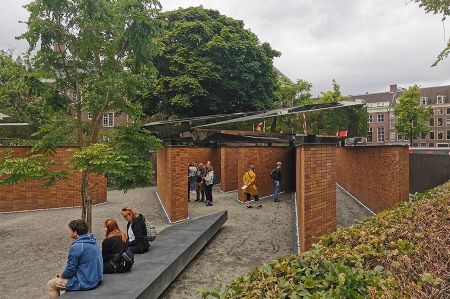 Prime Minister Mark Rutte and Amsterdam Mayor Femke Halsema, among others, spoke at the ceremony to hand over the monument. She regretted that the city had not adequately protected the Jewish population from persecution during the German occupation. According to Halsema, in May 1940 there were around 140,000 Jews living in the Netherlands, 80,000 of them in Amsterdam. Only 15,000 would have survived. These walls, the names carved here in stone, “stand like a fortress between us and oblivion.” Mark Rutte exclaimed that this monument says:
Prime Minister Mark Rutte and Amsterdam Mayor Femke Halsema, among others, spoke at the ceremony to hand over the monument. She regretted that the city had not adequately protected the Jewish population from persecution during the German occupation. According to Halsema, in May 1940 there were around 140,000 Jews living in the Netherlands, 80,000 of them in Amsterdam. Only 15,000 would have survived. These walls, the names carved here in stone, “stand like a fortress between us and oblivion.” Mark Rutte exclaimed that this monument says:
“No, we won’t forget you.
No, we will not allow your names to be erased.
No, evil does not have the last word.”
– Mark Rutte: Die Zeit, September 19, 2021
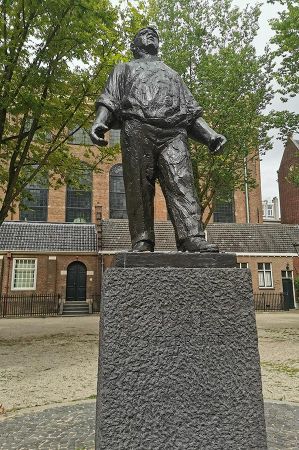 The prime minister self-critically added that the memorial forced the Netherlands to take account of the “cold reception” given to the few Jews who had survived the extermination camps in the East and returned. Rutte called this attitude “a black chapter in our history.” Jacques Grishaver characterizes the function of the monument - a place of remembrance for relatives, a place of enlightenment for young people: "The incredible number of 102,000 can now be visualized." Christoph Heubner, Executive Vice President of the International Auschwitz Committee, praised the endurance and determination of the initiators: “The decades-long struggle against indifference and pushing history aside was worth it.” Grishaver also addressed the delay in construction: “It was too late for many survivors, that is very bitter.”
The prime minister self-critically added that the memorial forced the Netherlands to take account of the “cold reception” given to the few Jews who had survived the extermination camps in the East and returned. Rutte called this attitude “a black chapter in our history.” Jacques Grishaver characterizes the function of the monument - a place of remembrance for relatives, a place of enlightenment for young people: "The incredible number of 102,000 can now be visualized." Christoph Heubner, Executive Vice President of the International Auschwitz Committee, praised the endurance and determination of the initiators: “The decades-long struggle against indifference and pushing history aside was worth it.” Grishaver also addressed the delay in construction: “It was too late for many survivors, that is very bitter.”
Please read as well:
Amsterdam – Historical urban development on the Amstel
Off to Hluboká nad Vltavou – Aleš Gallery awaits us
